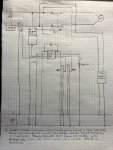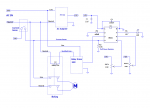Would I need a back suppression diode for a trim potentiometer that I am using as an input voltage. After replacing twice, they perform on the first run but after power removed the 10k full scale reads approx. 5k full scale (the center pin now goes from 0-5k instead of 0-10k).
Set Up:
-small purchased power supply module to convert 115-5V. (it was advertised as "precision" so i assumed it had the capacitors and diodes to protect downstream)
-O8M2 chip has two outputs: 1-LED/resistor 2-relay control board with small relay to control 115V 80A relay
- I did tie down the serial input to ground through a resistor and added the capacitor across V+ and Vo
My thinking now is when I drop the switch on the 115V side the 115V coil in the 80A relay sends a spike out on that side and the power supply lets the spike follow through to the 5V side. question is why the potentiometers and not the 08M2??
Set Up:
-small purchased power supply module to convert 115-5V. (it was advertised as "precision" so i assumed it had the capacitors and diodes to protect downstream)
-O8M2 chip has two outputs: 1-LED/resistor 2-relay control board with small relay to control 115V 80A relay
- I did tie down the serial input to ground through a resistor and added the capacitor across V+ and Vo
My thinking now is when I drop the switch on the 115V side the 115V coil in the 80A relay sends a spike out on that side and the power supply lets the spike follow through to the 5V side. question is why the potentiometers and not the 08M2??


